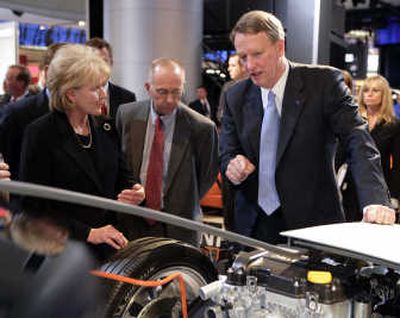Plugged in to change

WATERTOWN, Mass. – In a brick hall by the Charles River, where blacksmiths made cannons for the Union Army, a new breed of metalworker forges what may be the best weapon automakers will have for surviving the 21st century.
At the labs of A123 Systems, technicians assemble an electric heart for the Chevrolet Volt, a battery pack that will be shipped to General Motors Corp. for testing as the company races to build an electric vehicle by 2010.
For all the doubts about whether a tiny, 7-year-old company can essentially rewire the domestic auto industry, A123’s executives express abundant confidence in their invention.
“Today, we are providing enough batteries to power the equivalent of 100,000 vehicles,” said Ric Fulop, one of A123’s founders and its chief evangelist. “If you look at other technologies, they’re still in the lab. It’s years before they get into mass production.”
The hurdles to powering vehicles with electricity instead of oil have become less daunting in the past year, but they’re still towering:
•Cost. A battery pack for a single Chevy Volt would cost about $10,000 today.
•Safety. Protecting passengers in crashes and controlling hot batteries.
•Longevity. Guaranteeing 10 or 15 years of life from untested technology.
•Environment. How much electric vehicles can reduce global warming gases, if at all.
While GM’s plan to build a car that travels 40 miles on a single electric charge has galvanized the industry, most experts say the technology isn’t ready.
No battery today “does it all,” said Don Hillebrand, director of the Center for Transportation Research at Argonne National Laboratory. “But when you watch the history and the progress they’re making, they’re improving rapidly … Soon, they’ll have it.”
Because 78 percent of U.S. commuters drive fewer than 40 miles a day, a vehicle that could travel that distance on electricity could find widespread appeal.
But several automakers and analysts question the electric vehicle charge, saying that plug-in hybrids and Volt-type vehicles can’t make a major dent in U.S. oil demand before 2020, and that their extra expense and complexity will keep them rare.
Plug-in hybrids “aren’t viable in the next seven or eight years,” said Menahem Anderman, a battery industry consultant whose work is closely followed by many experts. “Even if existing technology can make it, automotive standards will require three to five years of testing in small volumes before anybody can seriously consider production.”
A123’s Fulop and other defenders argue that no other technology will deliver vehicles that can average the equivalent of 150 miles or more on a gallon of gasoline, and see a growing chorus of consumers who want to make an environmental statement with their cars.
Automakers have attempted to power their vehicles with electricity for more than 100 years, with little success. Only in recent years has a new generation of battery been advanced enough to revive the concept. Another motivating factor is tougher pollution rules that push automakers to get out of the fossil-fuel burning business.
Take that hunk of lead and acid under the hood of your car. To match the energy in a gallon of gasoline, you would need about one ton of those batteries. The nickel-hydride batteries in hybrids have twice the energy capacity per weight, but still lack enough capacity to power a regular-size vehicle.
Only with lithium-ion batteries, first sold by Sony in camcorders in 1991, did a design come close to the right levels of energy per pound. Most portable electronics use lithium batteries today, and Tesla Motors uses 6,831 standard lithium-ion cells to power its Roadster, which is supposed to begin regular production this month.
But industry executives say that Tesla has taken risks by going that route, and other automakers reject regular lithium batteries for a number of reasons. They are prone to overheating and are highly flammable, especially if punctured. They last just a few years at best, not the 10 years for which automakers usually certify their engines.
And solving those problems gets expensive. Experts estimate the battery pack in each $98,000 Tesla Roadster will cost $35,000, but Tesla executives have suggested that the cost is closer to $20,000.